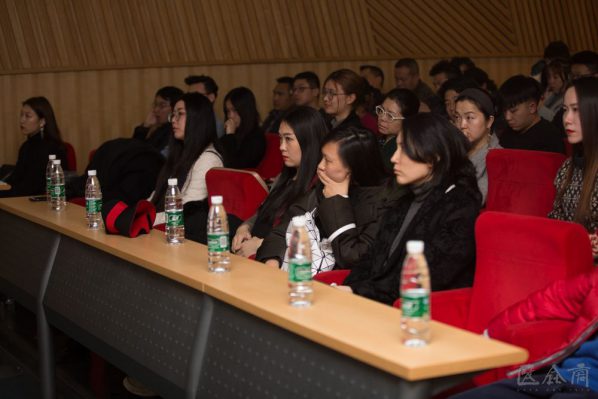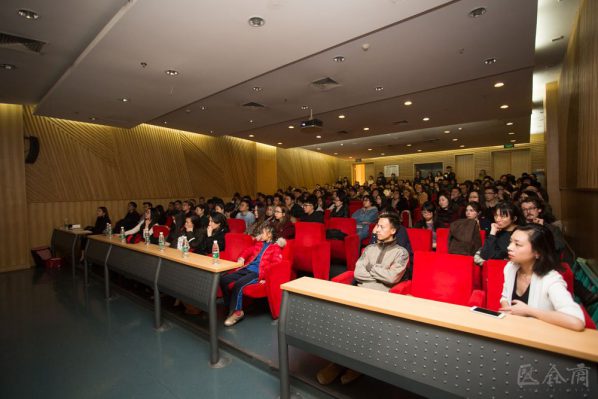
On the evening of March 3, 2017, co-sponsored by the School of Experimental Art, CAFA and the Unicorn Non-profit Art Center, offered a lecture entitled “CAFA CONFERENCE” in the Auditorium of Building 7, CAFA, and invited to present was the artist Niek Van de Steeg, a professor from the Ecole Nationale des Beaux-Arts de Lyon, France and a representative artist of “Relationship Aesthetics” of the 1990s. In this lecture, Niek mainly described his own 20 years in the art creating process, through the detailed descriptions of specific works and the introduction of major projects, he helped the audience experience the “relationship aesthetics”, exploring the sophisticated relationship between mankind, society, history, and time and space of an art from specific works, jointly discussing the possibilities of contemporary art built on the relationship in presenting and triggering relationships.
At the beginning of the lecture, Niek said that he was born in the Netherlands in 1961, received a professional art education in the Netherlands, and then he moved to France after graduating in 1985, he has been living for a while in Lyon, France. He has been teaching at the Ecole Nationale des Beaux-Arts de Lyon since 1990. Niek said that the work presented by this lecture was based on participation, which made the subject, object, people and environment alter. If you are interested in it, please browse http://www.dda-ra.org/fr/oeuvres/VAN-DE-STEEG where you can find all the works by Niek.

Niek introduced his work and first screened two short films entitled “Red Foot and Copper Water” (2016) and “Running Matter & Yellow Cake” (2012) to the audience. “Red Foot and Copper Water” is a shot of a red river flowing in the valley, and it contains 6 grams of metal material per liter of water in the river, the water is toxic and extremely acidic, but there are some microorganisms and the creatures that adapt to the very acidic water in the river, which constitutes an unique extremely acidic ecosystem in the world. Although the water could not be used for drinking or irrigation, the locals use the water to wash in to reduce the pain of skin diseases. In the film, the artist himself jumps into the river to clean the body, in order to illustrate the problem, including how the artist goes deep into things, the danger commonly faced by the artist and society and how to place the self in danger. In the film of “Running Matter & Yellow Cake”, the artist is dressed in red and running in a theme park, which was once an abandoned oil field, and the “landscape” of the film is a waste-yard filled with waste. In both films, the artist himself takes the role of “mover” or “actor” with a relationship with the environment for the narrative, placing himself in an environment of unknown physical harm, to explore the multiple relationships between the human, society and the environment are hidden in the “internal” of the environment.
In addition to the video, Niek’s works include paintings, installations, ceramics, and architecture. From 1990 to 2017, Niek finished a total of four large international art projects: Le Pavillon à Vent (1992-1993), Très Grande Administration Démocratique (1993-2000), Les Structures de Correction (1995-2017), and La Maison de la Matière Première (2007-2017). La Maison de la Matière Première is an art project completed in cooperation with other artists. In Niek’s view, the work “Yellow Cake and Black Coffee” perfectly represents the meaning of La Maison de la Matière Première. Coffee means relaxation in modern life while it also suggests the colonial history behind it, which forms an opposition and tension for the work.

As an exhibition, “Le Pavillon à Vent” is a “social event” about globalization and aboriginals and also a “utopian” discussion, to talk about the viewer’s society and the relationship between the whole world and the political world. The overall structure of the exhibition building resembles a Dutch windmill, and the “windmill” is a single “machine”, where the exhibition space keeps spinning.
It features four landscape paintings of different parts of Europe, which is related to changes in the marketing policy in Europe in 1992. “Le Pavillon à Vent” represented the view and questions the gradual integration of Europe and the borders which were gradually blurred at that time, namely whether it was a real utopia? How was the utopian life built in the flourishing age? In addition, a white architectural model of the “Le Pavillon à Vent” was placed outside the city of Nice, through a special perspective that is blended with the environment to forma “real” illusion of the image. At the same time, Niek built a number of factory models before the model of the “Le Pavillon à Vent”, to express the artist’s view on “the utopian formation which is determined by economic conditions”.
The first project of the Très Grande Administration Démocratique (The VGTA) is a governmental building built on the island of Sequin in the Seine and the building used cases and Renault’s recyclable boxes to create an architecturetotally 12 storeys which could be automatically changed, and each floor was represented by an alphabet of the French word “DEMOCRATIQUE”, while the artist made a special creation depending on the meaning of the vocabulary associated to the alphabet. Niek then introduced several typical works on each floor, such as a “conference room” imagined by the artist, was composed of recycled second-hand furniture, and it is also suggestive of the arrangement of the method of furniture. The artist also organized a debate in the “conference room”, with the participation of different representatives to discuss how to work in a complex environmen
The meaning of “Les Structures de Correction” means that an artist can change through an existing context. For example, Niek invited people who owned the tables to change part of the table, in order to tell all people that they had the ability to create. In a commercial center space, the artist built an unique space available for leisure, entertainment, and debate using plastic pipes, making asubtle and flexible transformation of the spatial nature and functionality of the business center. “Les Structures de Correction” was inspired by the “The VGTA” project, but it was eventually liberated from the project and formed an independent art project, the artist continued to create in various different public spaces, activating the potential possibility of establishing fresh relationships between people and space, things and space. At the end of the lecture, the artist Niek interacted with several of the audience at the scene and complemented them with richer details and backgrounds on the work.
Text by Wei Xiankun, Photo by Yang Yanyuan/CAFA ART INFO
Translated by Chen Peihua and edited by Sue/CAFA ART INFO




























